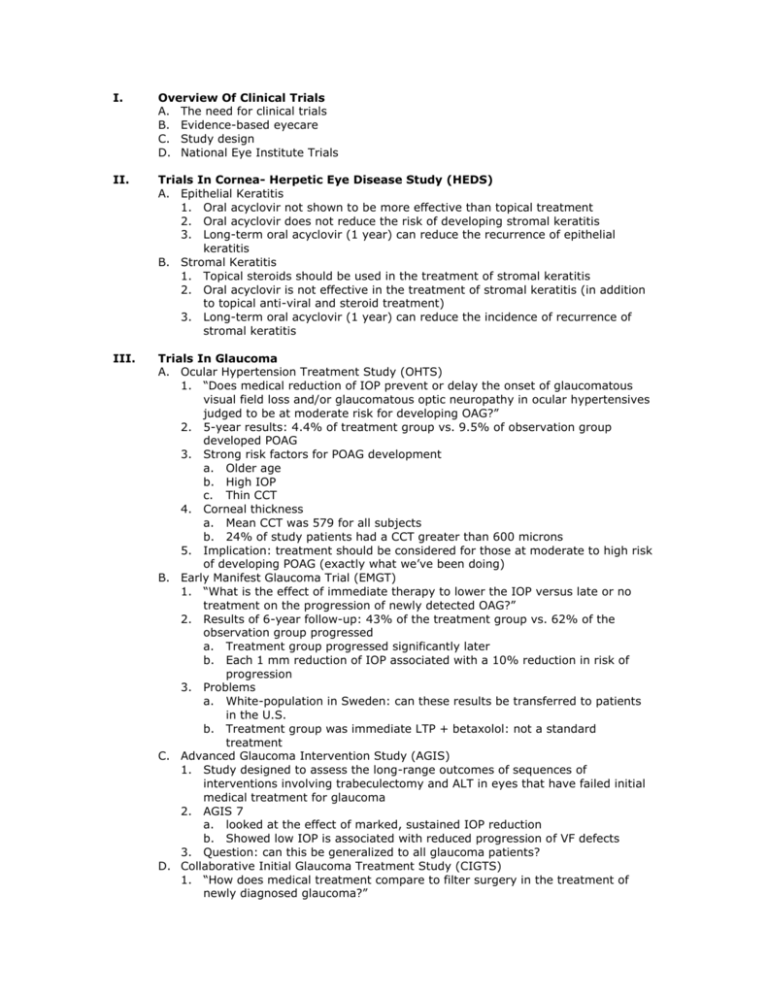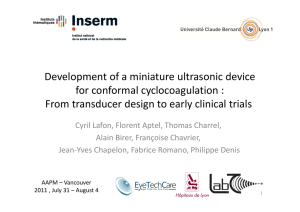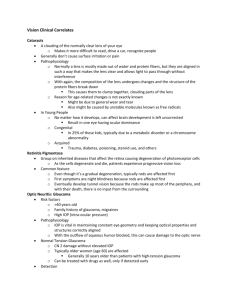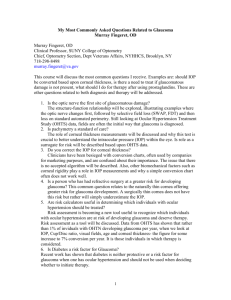THE IMPLICATIONS OF CLINICAL TRIALS ON PRIMARY
advertisement

I. Overview Of Clinical Trials A. The need for clinical trials B. Evidence-based eyecare C. Study design D. National Eye Institute Trials II. Trials In Cornea- Herpetic Eye Disease Study (HEDS) A. Epithelial Keratitis 1. Oral acyclovir not shown to be more effective than topical treatment 2. Oral acyclovir does not reduce the risk of developing stromal keratitis 3. Long-term oral acyclovir (1 year) can reduce the recurrence of epithelial keratitis B. Stromal Keratitis 1. Topical steroids should be used in the treatment of stromal keratitis 2. Oral acyclovir is not effective in the treatment of stromal keratitis (in addition to topical anti-viral and steroid treatment) 3. Long-term oral acyclovir (1 year) can reduce the incidence of recurrence of stromal keratitis III. Trials In Glaucoma A. Ocular Hypertension Treatment Study (OHTS) 1. “Does medical reduction of IOP prevent or delay the onset of glaucomatous visual field loss and/or glaucomatous optic neuropathy in ocular hypertensives judged to be at moderate risk for developing OAG?” 2. 5-year results: 4.4% of treatment group vs. 9.5% of observation group developed POAG 3. Strong risk factors for POAG development a. Older age b. High IOP c. Thin CCT 4. Corneal thickness a. Mean CCT was 579 for all subjects b. 24% of study patients had a CCT greater than 600 microns 5. Implication: treatment should be considered for those at moderate to high risk of developing POAG (exactly what we’ve been doing) B. Early Manifest Glaucoma Trial (EMGT) 1. “What is the effect of immediate therapy to lower the IOP versus late or no treatment on the progression of newly detected OAG?” 2. Results of 6-year follow-up: 43% of the treatment group vs. 62% of the observation group progressed a. Treatment group progressed significantly later b. Each 1 mm reduction of IOP associated with a 10% reduction in risk of progression 3. Problems a. White-population in Sweden: can these results be transferred to patients in the U.S. b. Treatment group was immediate LTP + betaxolol: not a standard treatment C. Advanced Glaucoma Intervention Study (AGIS) 1. Study designed to assess the long-range outcomes of sequences of interventions involving trabeculectomy and ALT in eyes that have failed initial medical treatment for glaucoma 2. AGIS 7 a. looked at the effect of marked, sustained IOP reduction b. Showed low IOP is associated with reduced progression of VF defects 3. Question: can this be generalized to all glaucoma patients? D. Collaborative Initial Glaucoma Treatment Study (CIGTS) 1. “How does medical treatment compare to filter surgery in the treatment of newly diagnosed glaucoma?” 2. Clinical Outcomes a. Average IOP was lower in the surgical group b. No significant difference in VF loss c. Surgical patients had a greater risk of substantial VA loss 3. Quality of Life Outcomes a. Little difference in functioning between the 2 groups b. Decline in symptoms over time c. Greater number of local eye symptoms in the surgical group 4. Results a. 5 years of follow-up not enough time to change our standard of treatment i.e. medicine b. Aggressive treatment as provided by this study associated with minimal VF loss over 5 years IV. Trials in Optic Nerve Disease A. A Review of the Optic Neuritis Treatment Trial (ONTT) 1. Results 2. Implications for primary optometric practice B. CHAMPS Study 1. Patients treated weekly with Avonex following first bout of optic neuritis (or other acute demyelinating event) have a reduction of progression to clinically definite MS by 50 percent over 2 years 2. Implications a. Treatment is now available which alters the rate of development of clinically definite MS after a first bout of optic neuritis b. Optometrists must be able to accurately diagnose optic neuritis and know the available treatment options V. Trials in Nutrition-AREDS A. Study results 1. Antioxidants and zinc reduce the risk of moderate vision loss from AMD by 19% 2. Antioxidants and zinc reduce the risk of developing advanced AMD by 28% 3. Lesser effect from antioxidants alone and zinc alone 4. No benefit for patients with early or no AMD B. Implications for clinical practice 1. Supplementation with antioxidants and zinc in the dosages used in the study are indicated for patients at high-risk for developing vision loss 2. Consultation with internist indicated 3. Watch for supplement-drug interactions and linkages such as beta-carotene and smoking 4. Supplementation with antioxidants and zinc in the dosages used in the study are not indicated for patients at low-risk for developing vision loss C. Issues 1. Are other dosages of these supplements better, worse, or the same? 2. Are other supplements e.g. alone or in combination better, worse, or the same? 3. Should we recommend supplements for patients with early or no AMD with strong family history of the AMD? 4. What will the long-term outcome be? VI. Trials in AMD A. Macular Photocoagulation Study 1. Guidelines 2. The need for other treatments besides those shown to be effective in the Macular Photocoagulation Study B. Photodynamic therapy 1. TAP Study a. Treatment of patients with predominantly classic CNV b. Three-year results i) Stabilization of vision ii) Safe iii) Requires multiple treatments 2. VIP Study a. Treatment of occult membranes b. Results i) No treatment benefit at 12 months ii) Clinically significant benefit at 24 months 3. Future Studies a. VER b. VIM C. Submacular Surgery Trials 1. Subfoveal CNV, some classic 2. Subfoveal CNV, > 50% blood 3. Subfoveal CNV from histo or idiopathic D. Other studies VII. Trials in Refraction A. Correction of Myopia Evaluation Trial (COMET) 1. Evaluating the effect of PAL’s vs. single vision lenses in slowing the progression of myopia I children 2. Results indicate small, significantly significant effect over 3 years; greater effect on those with accommodative problems B. A Trial of Bifocals in Myopic Children with Esophoria VIII. Trials in Amblyopia-Amblyopia Treatment Study A. ATS 1 1. Atropine as effective as patching in the treatment of moderate amblyopia 2. Initial treatment should be made by clinician and parent B. Future directions








